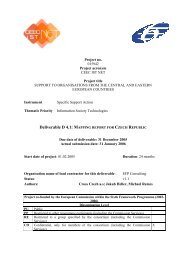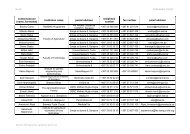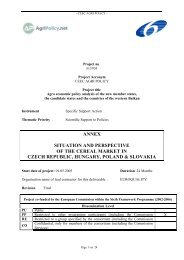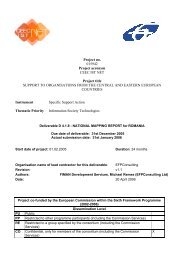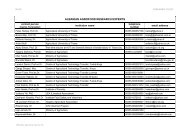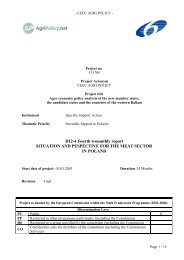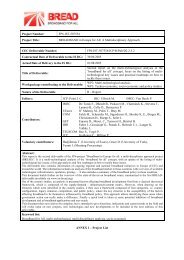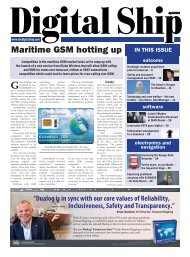Project Number: FP6-IST-507554 Project Title: BROADBAND in ...
Project Number: FP6-IST-507554 Project Title: BROADBAND in ...
Project Number: FP6-IST-507554 Project Title: BROADBAND in ...
You also want an ePaper? Increase the reach of your titles
YUMPU automatically turns print PDFs into web optimized ePapers that Google loves.
5. Related projects and standardisation<br />
Page 14 of 319<br />
<strong>FP6</strong>-<strong>IST</strong>-<strong>507554</strong>/JCP/R/Pub/D2.2-3.2<br />
The construction of a broadband <strong>in</strong>frastructure <strong>in</strong> Europe is part of the network evolution happen<strong>in</strong>g <strong>in</strong> all<br />
directions and creat<strong>in</strong>g different k<strong>in</strong>ds of technologies to address user requirements and develop<strong>in</strong>g appropriate<br />
bus<strong>in</strong>ess cases <strong>in</strong> the competitive global communication area. In this development standards and the<br />
standardization process are important components as they are serv<strong>in</strong>g as a foundation for <strong>in</strong>terwork<strong>in</strong>g and<br />
<strong>in</strong>teroperability of different networks, products and services that are key elements <strong>in</strong> realization of broadband<br />
based communication. As part of the development the concept of standards and process of standardization are<br />
chang<strong>in</strong>g from an ‘old regime’ based on national sovereignty, jo<strong>in</strong>t provision and <strong>in</strong>teroperability via standards<br />
to a ‘new regime based on liberalization, privatization and deregulation.<br />
In the old regime national sovereign states, usually represented by state monopolies met <strong>in</strong> organizations as ITU<br />
and CCITT to agree on standards that typically were enforced via the participat<strong>in</strong>g national entities as nationally<br />
rules that met at the borders. Interoperability was typically ensured via standardization of <strong>in</strong>terfaces, nationally<br />
based on a symbiosis between operators and equipment manufacturers.<br />
In the new regime the old organizations are transformed <strong>in</strong>to stakeholder for a and new organizations are<br />
created - broad as ETSI or more specialized one-issue organizations- where members discuss standards to be<br />
recommended (de facto). This is followed by a change <strong>in</strong> the <strong>in</strong>teroperability mechanisms now characterized by<br />
a deepen<strong>in</strong>g of standardization based on end-to-end considerations, where the elements <strong>in</strong> focus are companies /<br />
technical systems and not national entities.<br />
There are different types of organizations, which are partly substitut<strong>in</strong>g to the legacy standard bodies:<br />
• some are created when temporary needs occur; examples of that is DAVIC (Digital Audio-Visual<br />
Council from 1993 till 1998), or DVB (Digital Video Broadcast<strong>in</strong>g, still well alive) created with the<br />
advent of digital video.<br />
• Some committees have reached stability and now are recognized as standard bodies <strong>in</strong> their area, like<br />
IETF, or IEEE.<br />
• Some Forum or organizations like PLC Forum, ECCA, CableLabs, DSL forum,WIMAX have specific<br />
objectives, and sometimes a broader scope then produc<strong>in</strong>g standards.<br />
This change <strong>in</strong> regime has created new dynamic possibilities, but also bottlenecks and barriers creat<strong>in</strong>g obstacles<br />
to the development of broadband<br />
The major advantages of such approach are:<br />
• to create a natural consensus between all the actors of the delivery cha<strong>in</strong>, and allow them all to<br />
contribute and defend their own <strong>in</strong>terest; this on one end facilitate the adoption and endorsement of the<br />
produced standards, and on the other end to create a dynamic process as everybody will have common<br />
objective to support and deploy the standard<br />
• to clarify the market situation: as operators are committ<strong>in</strong>g to the process, vendors can have a clearer<br />
view on their <strong>in</strong>terest<br />
• to allow a fast specification delivery process; once the specifications are agreed , there is no need,<br />
except sometimes a regulatory constra<strong>in</strong>t, to have the specification adopted officially<br />
• an additional de facto advantage is the openness of most the consortium to every actor, whereas<br />
classical legacy standard associations have sometimes strict rules which can prevent all <strong>in</strong>terested<br />
parties to contribute efficiently<br />
Major issues to solve are:<br />
• The potential proliferation of competitive committees on the same areas, lead<strong>in</strong>g to a general confusion<br />
and lead<strong>in</strong>g more to proprietary solutions rather then largely adopted standards. This has already<br />
occurred <strong>in</strong> practice <strong>in</strong> some areas where standard bodies like ETSI are ratify<strong>in</strong>g competitive standards<br />
address<strong>in</strong>g the same area.<br />
• Legacy standardization bodies have a solid experience of ma<strong>in</strong>ta<strong>in</strong><strong>in</strong>g and upgrad<strong>in</strong>g standards, and<br />
ensur<strong>in</strong>g practical <strong>in</strong>teroperability and conformance to the standard, therefore the transition between<br />
specification production and standard stabilization phase can be very difficult.<br />
• Some particular consortium <strong>in</strong>terest (geographical for example) can prevent specifications to reflect<br />
worldwide requirement, and therefore create an unbalanced situation



